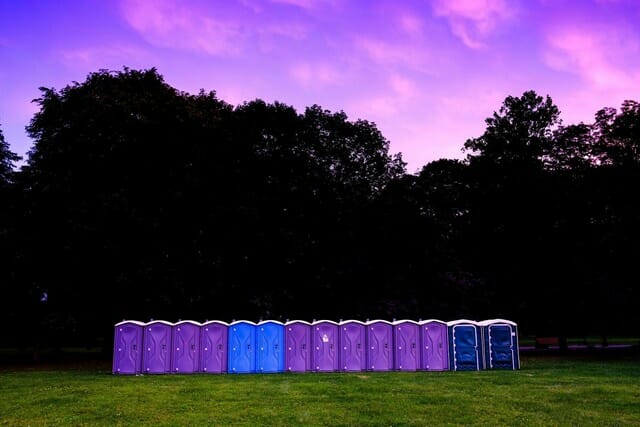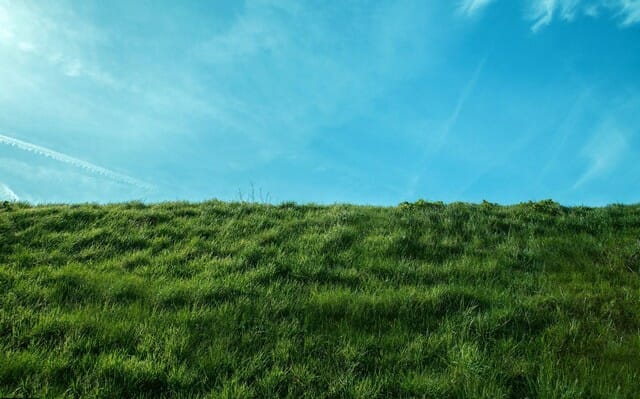Last Updated on April 4, 2022 by Grow with Bovees
The best time to apply milorganite will depend upon several factors, including the type of grass you have, soil temperature at the time of application. So, let’s get down to when you should put down Milorganite for best effect.
Milorganite is a slow releasing fertilizer which is a unique, organic fertilizer that is, believe it or not, the byproduct of a sewage treatment plant operated by the Milwaukee Metropolitan Sewerage District.
It is great to use Milorganite if you wish to maintain a healthy and green lawn that is able to develop strong deep roots.
How It Works
The sewage plant takes wastewater, separates the clean water, and puts it back in Lake Michigan. The organic microbes that have consumed the wastewater are heat dried and what’s left is what makes Milorganite lawn Fertilizer.

The Mysterious Contents of Milorganite
Yes, Milorganite does sound a little disgusting. But not to worry, there is a long history of using waste materials for fertilization.
And besides that, the waste is heated to incredibly high temperatures: 900 to 1200 degrees Fahrenheit. The fact that Milorganite is heat dried at such temperatures, ensures that it is free of pathogens and is totally safe to cover your lawn with.
If you don’t believe me, how about the US Environmental Protection Agency?
Once the waste material is dried, what follows is a meticulous testing process to ensure that Milorganite is totally safe to use on your lawn. The process follows the standards of the US EPA.
Using a waste product makes Milorganite an organic slow release fertilizer that’s filled with nutrients and sustainable for the environment. Milorganite is an excellent use of waste material and a revolutionary idea.
Milorganite’s slow release formula is safe to use when spreading new grass seed or to use on an already established lawn for added nutrients. It is also an excellent organic nitrogen fertilizer for shrubs, trees and vegetables.

Milorganite Application Schedule: How Much and How Often?
Getting your fertilizing schedule right means knowing how much fertilizer is needed and when the best time to apply and use Milorganite on your lawn is.
There’s no one schedule for all lawns as it depends on the climate of your area, soil temperature, how old your lawn is, and what grass type you have.
How Many Bags of Milorganite Do I Need per Acre?
If you measure your lawn in acres, the correct rate is five bags of Milorganite slow releasing fertilizer per quarter acre. If your total property is a quarter acre, you probably don’t need five bags of plant nutrients.
You don’t want to include parts of your property that aren’t going to be fertilized. These include the area of your house and any driveway or sidewalk that will not benefit from Milorganite.
Application Rates of Milorganite On Your Lawn
Here are the application rates for Milorganite for different sizes of property and lawn.
- ¼ acre = 5 bags
- ⅓ acre = 6 bags
- ½ acre = 9 bags
- ⅔ acre = 12 bags
- ¾ acre = 13 bags
- 1 acre = 18 bags
For smaller properties, it’s best to calculate your lawn in square feet.
Again, remember to deduct any part of your lawn that will not require you to use Milorganite on. This means sidewalks, patios, and driveways should not be included in the total, only the areas that are actually covered in lawn
Once you have your total square footage of the lawn, use the rate of one bag for every 2500 square feet. One bag of Milorganite is 32 pounds.
Calculating the Size of Your Lawn
A trick to measuring your property is to walk it. Each step you take is roughly equal to three feet.
Walk the length, then the width, and then multiply the totals together. Next, you have to minus the size of your house and the concrete or non-grassy areas.
If you want to find out how many acres you have, divide the square footage by 43,560.
What Is the Yearly Application Rate for Milorganite?
The magic number of times per year to apply Milorganite is, like many fertilizers, four times per year. This will keep your lawn looking great the entire time it’s not in dormancy.
If four times a year is too much of a strain on your time or budget, a second choice would be once a year.
You should apply Milorganite, with a broadcast spreader, in early fall to get your lawn prepared for winter and, more importantly, ready to break out in green next spring.
Add the product to the spreader, start at one end of your lawn, open the hopper vents of the spreader, and walk briskly across the lawn, evenly distributing the fertilizer across the grass.
Southern Warm-Season Grasses
If you live in the south, the common grass type is Bahia, Bermuda, Zoysia, Centipedegrass, or St. Augustine.
These grasses all thrive in the lovely southern climate. These warm season grasses love the long hot summers and grow fastest during this time.
Like most warm season grass, Zoysia, Bermuda, and St. Augustine will all benefit from a four times-a-year fertilization schedule.
Bahia and Centipede grass, on the other hand, are better off with just two applications per year. In this case, you should apply Milorganite, with a broadcast spreader, in spring — after the last frost disappears — and summer only.
A third application of this organic fertilizer in the fall or early october for these two kinds of grass could lead to winter kill or killing frost.
Imagine, after a long winter, when the last frost has melted, you wake up and see dead patches of discolored grass blades destroying the appearance of your backyard. A rude awakening if you ask me.
A Schedule for Applying Milorganite on Warm-Season Grass
People who live in the south and have warm season grasses, have a customized schedule to fertilize lawn with Milorganite. Here are the dates of when to use Milorganite and get the most out of your fertilization schedule.
- After dormancy (around Easter): 32 pounds per 2500 square feet.
- The end of May (Memorial Day): 32 pounds per 2500 square feet.
- The beginning of September (Labor Day): 32 pounds per 2500 square feet.
- Early October (during the fall overseeding): 32 pounds per 2500 square feet.
Northern Cool Season Grasses
The most common northern grasses are Fescue, Perennial Ryegrass, and Kentucky Bluegrass. The regions where you will find cool season grass are in the Northeastern US, the Pacific Northwest, and the northern half of the Midwestern US. These grasses prefer cool temperatures and see the highest growth rate in spring and fall.

A Schedule for Applying Milorganite on Cool Season Grasses
People with cool season grasses also have a unique fertilizing schedule and should fertilize the lawn about four times annually. Here are the key dates to apply Milorganite to a cool season grass, to supply continuous nutrients.
- End of May (Memorial Day): 32 pounds per 2 500 square ft.
- Early July ( July 4th weekend): 32 pounds per 2 500 square ft.
- Beginning of September (Labor Day): 32 pounds per 2 500 square ft.
- Second half of November (Thanksgiving): 32 pounds per 2 500 square ft.
Take note, that the last application of fertilizer should be done in late fall before the first snowfall or deep freeze, but as late in the season as possible.

Make sure not to run foul of any fertilizer blackout dates that may be applicable in your area, these are mostly from June thru September.
What You Need To Know: Fertilizing Your New Lawn with Milorganite Fertilizer
The excitement of starting and fertilizing new lawns can also be a point of anxiety. You might feel like a new parent and totally unprepared to create the best lawn possible.
Luckily, Milorganite Fertilizer application to the soil will put your mind at ease, and will quickly green up your grass, resulting in a beautiful lawn.
Before applying the grass seed, try mixing Milorganite into the top couple of inches of soil with a broadcast spreader. It’s a great way to create ideal conditions for growth.
Apply water to the ground before adding the fertilizer. This not only leaves the ground soft, aiding the milorganite to reach the base of the grass easier, but also helps with soil aeration, which is particularly important when trying to loosen up the hard surface of compact soil.
It is not a must to add water after the application of Milorganite. The product will remain in the soil until surrounding conditions are just right for the soil microbes present in the ground to break it down. After which the nutrients can then be used by the plant.
Next, wait for your seedlings to germinate. This means when you start to see the tops of the grass seed coming through your soil. Once the grass starts to break through the soil surface, and you have mowed your grass three times, you’re ready for your next application of Milorganite.
Since it’s a new lawn, you’re going to forget about the application amounts listed above. In fact, you’re going to use twice as much milorganite.
For the first year of your new lawn’s life, you will use two bags of Milorganite, or 64 pounds, for every 2500 square feet.
Once this first year is over, your lawn will be all grown up and can be called established. You’ll be like a proud parent and start the regular fertilizing schedule.
Milorganite Fertilizer Gives You Lush, Green Grass

Although you now know when to apply Milorganite, remember, it is not a cure-all. It won’t solve lawn problems like weeds, ants, and grubs. What it will do is give you lush green grass.
The above mentioned application rates and times are simply a general guideline as to how you should fertilize your grass.
If you are not sure of the suitable application rate in your region, have a look online and find local ordinances that are related to fertilizer application rates in your area.
Reusing waste makes Milorganite naturally high in iron. A natural product like this is much less likely to burn your lawn than a fertilizer that is high in nitrogen might.
Milorganite on your lawn is also less harmful for the environment, more sustainable, and better for future generations.
References;



